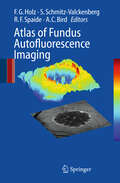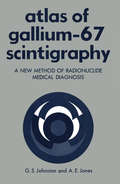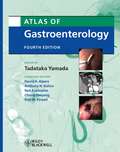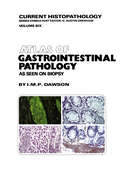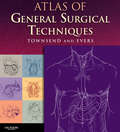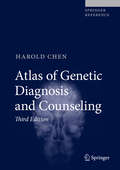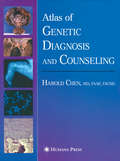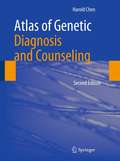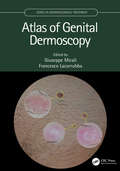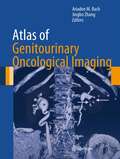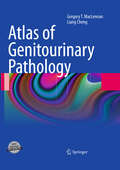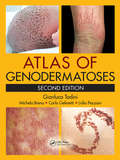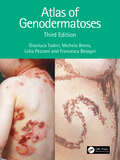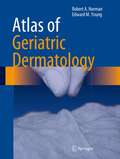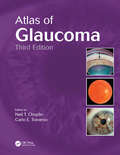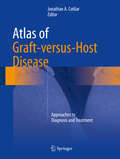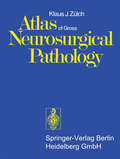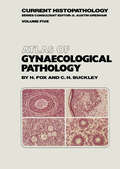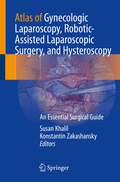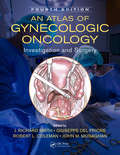- Table View
- List View
Atlas of Functional Shoulder Anatomy
by Giovanni Di Giacomo Nicole Pouliart Alberto Costantini Andrea De VitaThe anatomy of the shoulder is based on complex joint biomechanics. The purpose of this Atlas is to focus the reader’s attention on a series of bone, ligament, muscle and tendon structures and ultrastructures within the shoulder on which only the most recent international literature has reported in specialized journals. This Atlas also presents extremely high-definition images of "targeted" sections obtained from cadavers preserved using state-of-art techniques. This unique Atlas, making use of images of major visual impact, offers a scientific message on a topical joint, using simple but dedicated descriptive language.
Atlas of Fundus Autofluorescence Imaging
by Frank G. Holz Steffen Schmitz-Valckenberg Richard F. Spaide Alan C. BirdThis lavishly illustrated unique atlas provides a comprehensive and up-to-date overview of FAF imaging in retinal diseases. It also compares FAF findings with other imaging techniques such as fundus photograph, fluorescein- and ICG angiography as well as optical coherence tomography. General ophthalmologists as well as retina specialists will find this a very useful guide which illustrates typical FAF characteristics of various retinal diseases.
Atlas of Gallium-67 Scintigraphy: A New Method of Radionuclide Medical Diagnosis
by Gerald JohnstonIn 1970, under the sponsorship of Oak Ridge Associated Univer sities (ORAU), a group of clinical investigators formed the Cooper ative Group to Study Localization of Radiopharmaceuticals. The first radiopharmaceutical selected for study was 67-Gallium (67-Ga) administered as the citrate. The object of the study was to de termine the usefulness of 67-Ga in the diagnosis and treatment of patients with various malignancies. Funding for the project was granted by the U. S. Atomic Energy Commission and the National Cancer Institute, National Institutes of Health (NIH). The Nuclear Medicine Department of the Clinical Center, NIH, agreed to assist ORAU with aspects of this study, particularly with 67-Ga scin tigraphy of patients with lymphoma and Hodgkin's disease. Pre liminary reports from the ORAU study are in press. Since April 1971, 67-Ga scintigraphy has gained increasing use in the study of cancer patients at the Clinical Center, NIH, where well over 1000 such patients have been examined by this method. This monograph was written to present selected examples from this group of a variety of malignancies seen in this 28-month period. No attempt has been made to correlate this overall experience statistically. Rather, this presentation is to help familiarize the practitioner of Nuclear Medicine with the wide range of usefulness for 67-Ga scintigraphy while making him aware of the variation in scan appearance and watchful of the many pitfalls of 67-Ga scan interpretation. Permission to use these patient studies and x-rays was generously granted by Dr. Paul P.
Atlas of Gastroenterology
by David H. Alpers Anthony N. Kalloo Neil Kaplowitz Chung Owyang Don W. PowellAccurate, high-quality images are especially vital for gastrointestinal therapy. The Atlas of Gastroenterology is a gold-standard tool that provides specialists with an outstanding array of images covering all facets of the field. With endoscopic ultrasonographs, computed tomography scans, magnetic resonance images, radionuclide images, and angiograms demonstrating every clinical condition from liver abscess, to endocrine neoplasms of the pancreas, to motility disorders of the esophagus, this atlas is simply a must-own resource for all gastroenterologists. Showing the range of the newest imaging technologies and incorporating over 1700 full-color images, this new edition is an ideal teaching tool, and the perfect companion to the Textbook of Gastroenterology.
Atlas of Gastrointestinal Pathology: As Seen on Biopsy (Current Histopathology #6)
by M. Dawson T. MorsonBiopsy of the gastrointestinal tract has been revolution less busy) teaching hospital. These sort of techniques, which I confess interest me greatly because of the ized by the introduction of fibreoptics; the proximal additional information which they can yield when rightly reaches, as far as the second part of the duodenum, and chosen, are naturally linked with improved methods of the whole large bowel back to the caecum can now be tissue preservation in general, bearing in mind that the sampled under direct vision and multiple small biopsies need for special techniques often becomes apparent can be obtained. Only in the jejunum and ileum are there only when the biopsy has been conventionally still limitations on the sampling of localized as opposed to generalized conditions. The sheer volume of gastro processed and examined. However, I have firmly intestinal material passing through our own laboratories stabled this hobbyhorse and have included little that has risen steeply over the last years to form some 25% cannot be done in a district general hospital and nothing that I am not prepared to do myself. I have tried to of the total current work load and the rise continues; stress, particularly, common lesions which can cause nearly all of it is in biopsy form rather than as resected specimens.
Atlas of Gender and Health Inequalities in India (Demographic Transformation and Socio-Economic Development #16)
by Christophe Z. GuilmotoHow will the world's largest population approach its inequality challenges? This volume addresses this question by unraveling different strands of India's emerging health and gender geographies. It is the first book to offer a comparative study of these disparities in India, stressing the deep interaction between health challenges and patriarchal features. Most themes explored in this book illustrate the entangled nature of the social and regional determinants of gender and health imbalances in India. Through its rich cartography of contemporary India, the book represents the first Atlas exploiting district-level figures drawn from the latest sociodemographic survey conducted in 2019-21. After an initial methodological synopsis, the book is built around twenty chapters—illustrated by 75 original maps, figures, and tables prepared by thirty authors—and concludes with a synthesis of India's spatial patterns. Chapters engage with major themes of gender and health inequalities and explore an array of innovative indicators such as access to menstrual hygiene, cesarean deliveries, health insurance, son preference in fertility, female landownership, patrilocal systems, hypertension, anemia, hysterectomy, girl-only or single-child families, or traditional contraception. Together, they provide an often surprising glimpse into the present and future of India's gender and health landscape, highlighting the considerable progress accomplished over the last two decades alongside persistent gaps and emerging issues.
Atlas of General Surgical Techniques E-Book
by Courtney M. Townsend Jr. B. Mark EversAtlas of General Surgical Techniques covers the full spectrum and breadth of general surgery through nearly 1200 easy-to-follow anatomic drawings. Drs. Courtney M. Townsend, Jr. and B. Mark Evers present step-by-step guidance for common and complex procedures, including open and minimally invasive techniques. The highly consistent approach and format allow for large educational illustrations with pearls and pitfalls at the end of each chapter. Comprehensive coverage includes hot topics such as Thyroidectomy, Parathyroidectomy, Hepaticojejunostomy, Choledochojejunostomy, Splenectomy,Hernia Repair, Exploration of Neck for Trauma, and Subclavian Artery Stab. You’ll have a complete array of surgical procedures at your fingertips. 2009 PROSE Awards (awarded by Association of American Publishers for professional and scholarly excellence)Finalist/Honorable Mention, Clinical MedicineFeatures 1200 easy-to-follow, step-by-step anatomic drawings that clearly depict the full spectrum and breadth of surgical techniques—both open and minimally invasive. Covers hot topics such as Thyroidectomy, Parathyroidectomy, Hepaticojejunostomy, Choledochojejunostomy, Splenectomy, Hernia Repair, Exploration of Neck for Trauma, and Subclavian Artery Stab. Provides step-by-step instructions for each procedure in a highly consistent format that makes applying techniques easy. Highlights pearls and pitfalls at the end of each chapter so you know what to expect before entering the operating room. Presents the detailed guidance of authorities on what you need to know about common and challenging procedures.
Atlas of Genetic Diagnosis and Counseling
by Harold ChenThis book, Atlas of Genetic Diagnosis and understanding of these conditions and their care of Counseling, reflects my experience in 38 years of affected individuals and their families. It is also my clinical genetics practice. During this time, I have intention to bring the basic science and clinical m- cared for many patients and their families and taught icine together for the readers. Atlas of Genetic innumerable medical students, residents, and prac- Diagnosis and Counseling is designed for physicians ticing physicians. As an academic physician, I have involved in the evaluation and counseling of patients found that a picture is truly “worth a thousand with genetic diseases, malformations, and malfor- words,” especially in the field of dysmorphology. tion syndromes, including medical geneticists, Over the years, I have compiled photographs of my genetic counselors, pediatricians, neonatologists, patients, which are incorporated into this book to developmental pediatricians, perinatologists, obs- illustrate selected genetic disorders, malformations, tricians, neurologists, pathologists, and any phy- and malformation syndromes. A detailed outline of cians and health care professionals caring for each disorder is provided, describing the genetics, handicapped children such as craniofacial surgeons, basic defects, clinical features, diagnostic investiga- plastic surgeons, otolaryngologists, and orthopedics. tions, and genetic counseling, including recurrence I am grateful to many individuals for their risk, prenatal diagnosis, and management. Color invaluable help in reading and providing cases for photographs are used to illustrate the clinical fea- illustration.
Atlas of Genital Dermoscopy (Series in Dermatological Treatment)
by Giuseppe Micali Francesco LacarrubbaATLAS OF GENITAL DERMOSCOPY Edited by Giuseppe Micali, MD and Francesco Lacarrubba, MD Dermatology Clinic, University of Catania, Italy Dermoscopy, a non-invasive modern tool to enhance the diagnosis and monitoring of pigmented and non-pigmented skin disorders, is particularly suitable for use in the genital area, in which traditional invasive diagnostic procedures may be difficult or painful for the patient. Dermatologists, family physicians, and those involved in Sexual Health medicine will all benefit from this atlas showing the applications of dermoscopy in several external genital disorders both in males and females with large high-resolution color photographs throughout. Contents: Fordyce’s spots * Pearly penile papules and vestibular papillae * Genital warts * Molluscum contagiosum * Scabies* Pediculosis pubis * Candidiasis * Lichen planus * Lichen sclerosus * Lichen simplex chronicus * Zoon mucositis * Psoriasis * Vitiligo * Hidradenitis suppurativa * Melanosis * Dowling-Degos disease * Angiokeratoma * Lymphangioma circumscriptum * Melanocytic nevi * Seborrheic keratosis * Median raphe cyst * Squamous cell carcinoma in situ * Invasive squamous cell carcinoma * Extramammary Paget's disease * Melanoma
Atlas of Genital Dermoscopy (Series in Dermatological Treatment)
by Giuseppe Micali Francesco LacarrubbaATLAS OF GENITAL DERMOSCOPY Edited by Giuseppe Micali, MD and Francesco Lacarrubba, MD Dermatology Clinic, University of Catania, Italy Dermoscopy, a non-invasive modern tool to enhance the diagnosis and monitoring of pigmented and non-pigmented skin disorders, is particularly suitable for use in the genital area, in which traditional invasive diagnostic procedures may be difficult or painful for the patient. Dermatologists, family physicians, and those involved in Sexual Health medicine will all benefit from this atlas showing the applications of dermoscopy in several external genital disorders both in males and females with large high-resolution color photographs throughout. Contents: Fordyce’s spots * Pearly penile papules and vestibular papillae * Genital warts * Molluscum contagiosum * Scabies* Pediculosis pubis * Candidiasis * Lichen planus * Lichen sclerosus * Lichen simplex chronicus * Zoon mucositis * Psoriasis * Vitiligo * Hidradenitis suppurativa * Melanosis * Dowling-Degos disease * Angiokeratoma * Lymphangioma circumscriptum * Melanocytic nevi * Seborrheic keratosis * Median raphe cyst * Squamous cell carcinoma in situ * Invasive squamous cell carcinoma * Extramammary Paget's disease * Melanoma
Atlas of Genitourinary Oncological Imaging (Atlas of Oncology Imaging #1)
by Ariadne M. Bach and Jingbo ZhangThe Atlas of Genitourinary Oncological Imaging presents a comprehensive visual review of appearances for normal anatomy and oncological diseases in the genitourinary system using over 900 radiological images and illustrations. The book presents current imaging techniques and discusses the role of imaging in pre-treatment staging and post-treatment follow-up. Diseases discussed include kidney, adrenal gland, upper tract, bladder, prostate, testes, and pediatric malignancies. Individual chapters include normal anatomy, imaging techniques, and pathology of each cancer type. The staging of the malignancy and what to include in the radiology report are discussed, and expected and complicated postoperative and post-treatment findings and recurrence are presented. Dedicated chapters on interventional and radiation therapy discuss their unique role in the management and treatment of oncology of the genitourinary system. Additionally, a chapter on chemotherapy toxicities discusses drug reaction treatment therapies unique to the genitourinary system.Edited and written by radiologists from the genitourinary disease management team at Memorial Sloan-Kettering Cancer Center, the Atlas of Genitourinary Oncological Imaging is an ideal resource for radiology and urology trainees seeking a review of the basics and for practicing radiologists looking for answers to challenging cases confronted in daily practice.
Atlas of Genitourinary Pathology
by Gregory T. MacLennan Liang ChengA single source of information about pathologic lesions of the adrenal, the urinary tract, and the male genital system, minimizing the need to consult numerous texts of limited scope, this book contains gross photos and photomicrographs of virtually every pathologic entity, and variants of those entities. The book is lavishly illustrated with images accompanied by text that explains the visual images, highlighting key diagnostic features and providing brief but helpful discussions of the differential diagnosis. This book is designed for practicing pathologists and pathologists in training as well as urologists, GU radiologists, GU radiation oncologists, and GU medical oncologists.
Atlas of Genodermatoses
by Gianluca Tadini Michela Brena Carlo Gelmetti Lidia PezzaniDiagnosing a genetic skin disease can sometimes be a difficult task for a dermatologist. This is especially true for genodermatoses-generally considered rare diseases seldom seen by practicing clinicians. As a result, professionals often have little experience with their diagnosis. The Atlas of Genodermatoses presents a unique collection of such ca
Atlas of Genodermatoses
by Gianluca Tadini Michela Brena Lidia Pezzani Francesca BesagniGenodermatoses are often considered rare diseases seldom seen by practicing clinicians, but as a result, professionals often have little experience or confidence with their diagnosis when they are called upon for a clinical case.This text presents a comprehensive illustrated overview of almost 200 inherited diseases of the skin, hair, and nails. Examples have been expanded, with new images added to provide clear examples, alongside coherent and comprehensive explanations to enable clinicians to easily identify and source relevant information. This resource encompasses a varied range of skin diseases, providing accessible and in-depth information to help familiarise clinicians. The entry for each disease provides background, followed by common characterisations, manifestations, laboratory findings, genetics, cutaneous and extracutaneous findings, differential diagnosis, an overview of complications and recommended follow-ups.Authored by dermatologists and geneticists, this is an atlas of scientific research which updates established information with current studies and references. In its third edition, this text becomes an invaluable resource for dermatologists and pediatricians.
Atlas of Genodermatoses
by Gianluca Tadini Michela Brena Lidia Pezzani Francesca BesagniGenodermatoses are often considered rare diseases seldom seen by practicing clinicians, but as a result, professionals often have little experience or confidence with their diagnosis when they are called upon for a clinical case.This text presents a comprehensive illustrated overview of almost 200 inherited diseases of the skin, hair, and nails. Examples have been expanded, with new images added to provide clear examples, alongside coherent and comprehensive explanations to enable clinicians to easily identify and source relevant information. This resource encompasses a varied range of skin diseases, providing accessible and in-depth information to help familiarise clinicians. The entry for each disease provides background, followed by common characterisations, manifestations, laboratory findings, genetics, cutaneous and extracutaneous findings, differential diagnosis, an overview of complications and recommended follow-ups.Authored by dermatologists and geneticists, this is an atlas of scientific research which updates established information with current studies and references. In its third edition, this text becomes an invaluable resource for dermatologists and pediatricians.
Atlas of Geriatric Dermatology
by Robert A. Norman Edward M. Young, JrThis is a comprehensive, practical, densely illustrated diagnostic and therapeutic guide for all geriatric dermatology providers. The book comprises 50 chapters and over 600 color photographs on topics ranging from common conditions such as basal cell carcinoma, rosacea, and seborrheic dermatitis to unusual conditions such as angiosarcoma, dermatofibrosarcoma protuberans, and porphyria cutanea tarda.Sections include:- Inflammatory conditions (including contact dermatitis, alopecia, erythema multiforme, pemphigus, bullous pemphigoid, porphyria, pruritus, psoriasis, rosacea, seborrhea, urticaria, xerosis, and more)- Infections (fungus, herpes simplex and zoster, scabies, lice, and warts)- Skin signs in systemic disease (skin tags, cutaneous metastases, xanthomas)- Regional dermatoses (intertrigo, leg ulcers, pressure sores)- Benign tumors (chondrodermatitis, cysts, ganglion, fibrous papule, seborrheic keratoses, lentigines, and benign vascular lesions)- Pre-malignant and malignant tumors (actinic keratoses, angiosarcoma, basal cell carcinoma, dermatofibroma and dermatofibrosarcoma protuberans, intraepidermal neoplasia, Kaposi's sarcoma, keratoacanthoma, lentigo maligna, cutaneous lymphoma, Mycosis fiungoides, melanoma, nevi and moles, and squamous cell carcinoma)
Atlas of Glaucoma
by Neil T. Choplin Carlo E. TraversoGlaucoma affects all age groups and is a leading cause of blindness worldwide. It is imperative that practicing clinicians and surgeons recognize both primary and secondary glaucoma as well as cases of glaucoma associated with other disorders. Atlas of Glaucoma, Third Edition provides an in-depth review and analysis of the management of glaucoma an
Atlas of Glaucoma
by Neil T. Choplin Carlo E. TraversoGlaucoma affects all age groups and is a leading cause of blindness worldwide. It is imperative that practicing clinicians and surgeons recognize both primary and secondary glaucoma as well as cases of glaucoma associated with other disorders. Atlas of Glaucoma, Third Edition provides an in-depth review and analysis of the management of glaucoma an
Atlas of Graft-versus-Host Disease: Approaches to Diagnosis and Treatment
by Jonathan A. CotliarThis atlas provides trainees and practicing physicians a visual toolkit to help recognize and manage this difficult condition appropriately. This text highlights the clinical variability of GVHD, and arms readers with the diagnostic clues to categorize patients according to the current grading/staging guidelines. Furthermore, this atlas offers evidence-based diagnostic and treatment algorithms for physicians to use while at patients' bedsides.
Atlas of Gross Neurosurgical Pathology
by K.J. ZülchThis Atlas is one of a series devoted to neurosurgical and neuro logical conditions and is complementary to Atlas of the Histology of Brain Tumors (Springer-Verlag, Berlin-Heidelberg-New York 1971), which was the first in the atlas series. The Atlas is based on the Handbuch der Neurochirurgie, Vols. I and III (Springer 1956, 1959) but, whereas this is a comprehensive reference work, the present book is intended to give the practicing neurosurgeon, neuroradiolo gist, neuropathologist and neurologist the concise information they need for diagnostic purposes concerning the aspect, site, and ma lignancy of tumors and other space-occupying lesions in the brain. The schematic diagrams showing the sites of predilection of these tumors, as well as a piOgnosis based on the degree of malignancy, will be most useful here. The early chapters discuss the general rules governing displace ments due to space-occupying lesions and the manifestations of brain herniations. Other neurosurgical conditions, such as localized inflammatory processes, edema and obstructive hydrocephalus, are dealt with in brief chaptets; in this case I have chosen to show some of the rarer conditions rather than all the common lesions. In spite of probable future changes in terminology and classification, we have retained the classification used in the Atlas of Histology of Brain Tumors.
Atlas of Gynaecological Pathology (Current Histopathology #5)
by H. Fox C.H. Buckleycourse, also aware that many who use this volume One in every three slides examined by a general diagnostic pathologist in the United Kingdom, and will be well familiar with the classical, or 'textbook', in most other countries, comes from a gynaecological appearances of most of the more common conditions patient. Few pathologists can hope, therefore, to and have therefore often chosen an example which, escape a constant exposure to gynaecological path whilst being typical, is not necessarily classical. ology, and it is the aim of this atlas to lessen the We have deliberately chosen not to include any difficulties of this diagnostic burden by acting as an illustrations of gross specimens. This is partly because illustrated guide to the histological diagnosis of of ou r view that such illustrations are of I ittle real value female genital tract abnormalities. to any but the least experienced of pathologists, and Gynaecological pathology does, however, pose a partly because their inclusion would have narrowed number of specific problems: the range and scope of still further our selection of histological figures.
Atlas of Gynecologic Laparoscopy, Robotic-Assisted Laparoscopic Surgery, and Hysteroscopy: An Essential Surgical Guide
by Susan Khalil Konstantin ZakashanskyThis surgical atlas of laparoscopic, hysteroscopic, and robotic gynecologic procedures includes contemporary images. With endoscopic innovation and technology this resource includes access to high quality images essential for medical education and surgical procedures.This atlas serves to address gaps in high quality, up-to-date images and online access to a concise reference. This atlas includes surgical anatomy and different disease sites, including the uterus, ovaries, and vasculature of the pelvis. Chapters then move to cover specific diseases and the common and uncommon gynecologic procedures to treat them. This includes endometriosis, uterine pathology, and adnexal masses/ovarian cysts. Chapters are enhanced by high quality images and online reference access. This is an ideal guide for gynecological surgeons, gynecologic surgical subspecialty fellows, gynecologists, and residents.
An Atlas of Gynecologic Oncology: Investigation and Surgery, Fourth Edition
by J. Richard Smith Giuseppe Del Priore Robert L. Coleman John M. MonaghanThe latest edition of An Atlas of Gynecologic Oncology continues its coverage of the innovative techniques in investigation and surgery on the brink of becoming established as part of the gynecologic surgeon’s repertoire, now including the exciting developments in uterine transplantation.

